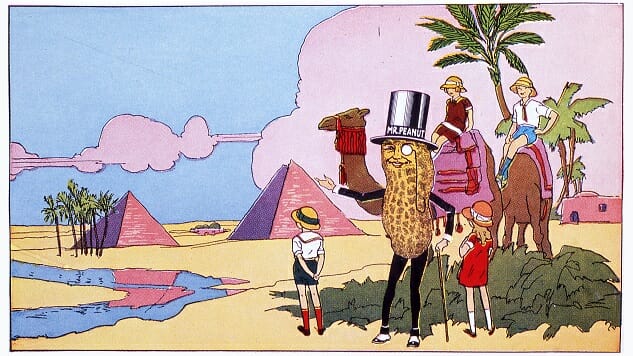Mr. Peanut: Dead at 104
Main and lead images courtesy of Getty, depicting Mr. Peanut in happier times.
Did you know corporate mascots could die? Normally they just quietly disappear when a company shifts from one advertising campaign to another. Today, though, has brought word of the startling end of Mr. Peanut, the classy and refined peanut who pitched for Planters for over a century. The sad “news” was announced by the official Mr. Peanut Twitter account.
It is with heavy hearts that we confirm that Mr. Peanut has died at 104. In the ultimate selfless act, he sacrificed himself to save his friends when they needed him most. Please pay your respects with #RIPeanutpic.twitter.com/VFnEFod4Zp
— The Estate of Mr. Peanut (@MrPeanut) January 22, 2020
His death arrived, naturally enough, in a Super Bowl ad also featuring Wesley Snipes and Matt Walsh (of Veep and the Upright Citizens Brigade). No doubt his inevitable return after this shameless stab at attention wraps up will come during the next Super Bowl, or some other highly visible advertising opportunity.
Mr. Peanut made his first appearance for Planters in 1916, in the midst of a damnable war that coated Europe with blood and ash like so many peanut shells on a baseball field’s grandstand. The dapper goober’s real name, apparently, is Bartholomew Richard Fitzgerald-Smythe, and his roots trace back to England, which means he’s a true colonizer, as peanuts were unknown to Europeans until Columbus. With his top hat, monocle and spats, he embodied the sartorial stereotype of the idle elite, of the high-rolling city swell, of the robber baron and the aloof billionaire. His real origins were humbler, though: inspired by a Wilkes-Barre schoolboy’s contest entry, Mr. Peanut debuted into society with a 1917 newspaper ad promoting Planter’s Pennant brand of peanuts. He didn’t quite have the jaunty joie de vire he came to be known for—like early Halloween costumes and cartoon characters, this Mr. Peanut isn’t just old as hell but looks like he came straight from its fiery depths. Here’s the ad in question, as it ran in The Barre Daily Times on Sept. 6, 1917, and as found on Wikipedia.
-

-

-

-

-

-

-

-

-

-

-

-

-

-

-

-

-

-

-

-

-

-

-

-

-

-

-

-

-

-

-

-

-

-

-

-

-

-

-

-









































